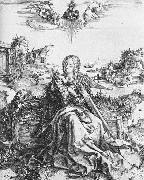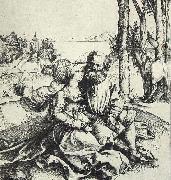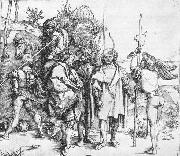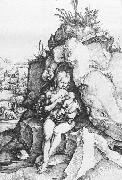
|
Artists
Index
|
||
|
Albrecht Durer
|
||
|
The Virgin with the Dragonfly new21/Albrecht Durer-356767.jpg Gemälde IDENTIFIZIERUNG:: 63564 |
1495 Engraving, 240 x 186 mm Staatliche Museen, Berlin The first of D?rer's engravings bearing a monogram and the only one with this archaic version of it. The dragonfly has been variously identified as a grasshopper, a praying mantis and a butterfly. The composition is still primitive, although the severely foreshortened head of St Joseph - asleep and old to stress the notion of Mary's virginity - is in marked contrast to earlier still extant drawings by D?rer of this subject. The sheet is a direct successor to Martin Schongauer's work.Artist:D?RER, Albrecht Title: The Virgin with the Dragonfly Painted in 1501-1550 , German - - graphics : religious | |
| |
|
|
|
|
||
|
The Ill-Assorted Couple or the Offer of Love new21/Albrecht Durer-534245.jpg Gemälde IDENTIFIZIERUNG:: 63565 |
1495 Engraving, 151 x 139 mm Staatliche Museen, Berlin The style of the monogram indicates that it is one of D?rer's earliest engravings. The left-handedness of the subjects may be due to D?rer's use of an earlier model. Although a moralizing theme was read into the episode by some early commentator, D?rer probably intended to do no more than to portray purchased love.Artist:D?RER, Albrecht Title: The Ill-Assorted Couple or the Offer of Love Painted in 1501-1550 , German - - graphics : genre | |
| |
|
|
|
|
||
|
Five Lansquenets and an Oriental on Horseback new21/Albrecht Durer-682377.jpg Gemälde IDENTIFIZIERUNG:: 63566 |
1495 Engraving, 132 x 147 mm Metropolitan Museum of Art, New York In early commentaries the scene was described as a band of robbers attacking D?rer, or as William Tell. More recently it has been suggested that it had originally been intended as a scene beneath the Cross. Italian influence is manifest, but the grouping, particularly the position of the Oriental horseman, is a little awkward. Note the scotch plaid pattern of the Turk's saddlecloth.Artist:D?RER, Albrecht Title: Five Lansquenets and an Oriental on Horseback Painted in 1501-1550 , German - - graphics : other | |
| |
|
|
|
|
||
|
St Jerome Penitent in the Wilderness new21/Albrecht Durer-844826.jpg Gemälde IDENTIFIZIERUNG:: 63567 |
1496 Engraving, 324 x 228 mm Metropolitan Museum of Art, New York The stone in the saint's right hand serves to strike his chest. In this engraving too Italian influence is manifest. The scenery in the background, however, is based on sketches of quarries in the vicinity of Nuremberg). There is a certain lack of cohesion between the various parts of this unusually large plate. St Jerome, one of the most learned Fathers of the Church and author of the Vulgate, was born in 331 or 342 in Dalmatia of a well-to-do family. He died in 420. He was one of the favourite saints of D?rer's time, but, curiously, Martin Luther was less than fond of him. "I know of no one among the teachers whom I bear as much enmity as St Jerome, for he speaks only of fasting, virginity, etc."Artist:D?RER, Albrecht Title: St Jerome Penitent in the Wilderness Painted in 1501-1550 , German - - graphics : religious | |
| |
|
|
|
|
||
|
The Penance of St John Chrysostom new21/Albrecht Durer-546683.jpg Gemälde IDENTIFIZIERUNG:: 63568 |
1496 Engraving, 180 x 119 mm Metropolitan Museum of Art, New York St John Chrysostom, a poor student at school, in desperation kissed the image of the Holy Virgin. To the amazement of his fellow students he henceforth wore a golden circle around his mouth and therefore was called "golden-mouthed" (in Greek, chrysostomos). The Pope ordained him a priest at the age of sixteen, but St John Chrysostom felt unworthy of the priesthood and became a hermit in the desert. There the Emperor's daughter, having lost her way one day, sought refuge in his cave. Upon her insistence he admitted her and they sinned. As penance he vowed to walk on all fours until forgiven. Years later the Empress gave birth to another child who refused baptism except from St John Chrysostom. Everyone despaired of finding him, when some hunters brought a strange wild animal to the festivities. The child, seeing the animal, said, "You are forgiven." St John stood up and shed his long moss-covered hair, and the Pope recognized him. The courtiers searched the desert and found the Emperor's daughter, who had also survived the ordeal in the wilderness. Mrs. Heaton, D?rer's first biographer in English, describes the scene very poignantly: "The princess is quite naked and more graceful in form and more beautiful of face than most of D?rer's female figures. There is a certain tenderness about her that makes us think that perhaps D?rer's sympathies were not entirely with the repentant saint who is seen in the background." The composition was perhaps suggested to D?rer by Jacopo de Barbari's engraving Cleopatra (or vice versa). Raphael must certainly have known this engraving since he borrowed the landscape and the castle, which appear the same in the Oxford drawing for Raphael's Pasadena Madonna and Child. D?rer's figures, however, were of no interest to Raphael. | |
| |
|
|
|
|
||
| Vorheriger Künstler Nächster Künstler | ||
|
Also Buy::. For Following Paintings / Artists / Products, Please Use Our Search Online: |










